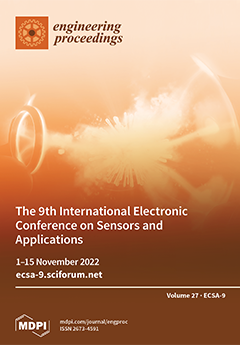The UV-Vis absorption, fluorescence, and phosphorescence spectra of poly(3,4-ethylenedioxythiophene/cucurbit[7]uril), polypseudorotaxane (
1), and polyrotaxane (
2) in water and acetonitrile solutions were investigated. To achieve a deeper insight into the optical properties, the transient absorptions, lifetimes, and quantum yields have been
[...] Read more.
The UV-Vis absorption, fluorescence, and phosphorescence spectra of poly(3,4-ethylenedioxythiophene/cucurbit[7]uril), polypseudorotaxane (
1), and polyrotaxane (
2) in water and acetonitrile solutions were investigated. To achieve a deeper insight into the optical properties, the transient absorptions, lifetimes, and quantum yields have been carried out on compounds
1 and
2. The transient absorption demonstrated an excited-state processes and involvement of high energy electronic states (S
n > 1). The transient absorption map in acetonitrile revealed at 210, 240, 300, and 315 nm a ground states bleaching bands (GSB), whereas at shorter wavelengths an absorption in excited states (ESA) and more than one excited state (S
n > 1). At 382 and 420 nm wavelength two negative bands appeared which were assigned to the stimulated emissions (SE). At longer wavelengths, i.e., 605, 625, and 710 nm, other stimulated emissions appeared that are probably a result of the triplet manifold, confirming their phosphorescence properties. Additionally, the quantum yield with absolute values in the range 5–25%, and phosphorescence lifetime with values in the range 1–9 μs were evaluated.
Full article




